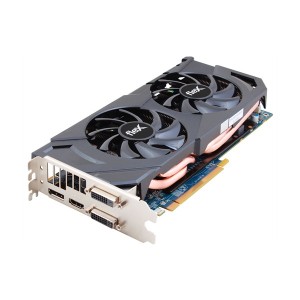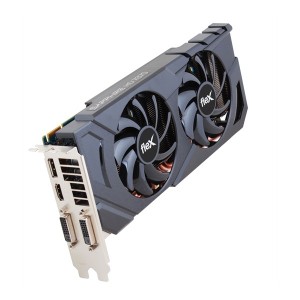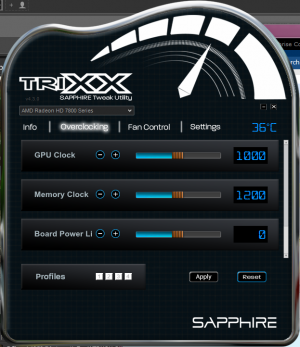 AMD’s Eyefinity technology is becoming easier and easier to implement, especially as more games support it and displays are becoming increasingly more affordable. For many gamers (especially with the resurgence in PC gaming and many exciting games coming soon), new rigs are being built and the multi-monitor question looms.
AMD’s Eyefinity technology is becoming easier and easier to implement, especially as more games support it and displays are becoming increasingly more affordable. For many gamers (especially with the resurgence in PC gaming and many exciting games coming soon), new rigs are being built and the multi-monitor question looms.
SAPPHIRE has long been one of AMD’s best board manufacturing partners. They manage to take the reference designs and really make something special out of them, most notably offering innovative cooling designs and increased flexibility options. Those who look for Radeon cards that have special use cases, such as small form factors, often turn to SAPPHIRE as a solid brand choice.
That’s where they’re positioning the FleX series of GPUs, and today they released a line of GCN (Graphics Core Next, AMD’s 28nm process-built overhaul of consumer graphics technology) GPUs that offer increased, well, FleXibility for Eyefinity options.
FleX is so named because they allow three DVI monitors to be used for Eyefinity, where most normal Radeon cards require at least one of them to be DisplayPort monitors. From their press release:
Most graphics cards based on AMD technology require the third monitor in an Eyefinity set-up to be a DisplayPort monitor, or connected with an active DisplayPort Adapter. The SAPPHIRE FleX family can support three DVI monitors in Eyefinity mode and deliver a true SLS (Single Large Surface) work area without the need for active adapters. The first two monitors are connected to the two DVI ports and the third to an HDMI to DVI cable (supplied) with no extra active hardware required. The DisplayPort outputs are still available for the connection of additional monitors
This means no extra expensive adapters are needed; SAPPHIRE includes everything you need in the box to get three DVI monitors going in Eyefinity; and the fact that we’re talking about a 7870 means it’s gonna push all three of those screens at an excellently high level of performance.
Specs
| Output | 1 x Dual-Link DVI 1 x HDMI (with 3D) 1 x DisplayPort 1 x Single-Link DVI-D DisplayPort 1.2 |
| GPU | 1000/1050 MHz Core Clock 28 nm Chip 1280 x Stream Processors |
| Memory | 2048 MB Size 256 -bit GDDR5 4800/5000 MHz Effective |
| Dimension | 260(L)x113(W)x35(H) mm Size. |
| Software | Driver CD SAPPHIRE TriXX Utility |
| Accessory | CrossFire™ Bridge Interconnect Cable DVI to VGA Adapter 6 PIN to 4 PIN Power Cable x 2 HDMI to SL-DVI Adapter(Full Retail SKU only) HDMI 1.4a high speed 1.8 meter cable(Full Retail SKU only) |
This particular SAPPHIRE Radeon 7870 also supports 4K resolution (4096×2160), ZeroCore power (3w power draw at idle), Eyefinity 2.0 support (including more bezel management options and 3D support), and SAPPHIRE’s exclusive Dual-Extractor heatsink with dual fans.
Benchmarks
A video card review isn’t a video card review without benchies, right? Right. The benchmark system is an AMD Phenom II X6 1100T, 4gb of RAM, 120gb OCZ Vertex 3 SSD, Windows 7 64bit, and Catalyst 12.6 beta drivers.
3DMark 11
Futuremark’s 3DMark 11 is the standard for punishing benchmarking of DirectX 11 GPUs. It offers two modes that really matter: a P score and an X score. P stands for Performance, and runs the benchmark at 1280×720 (720p), while X is Xtreme, and runs the benchmark at 1920×1080 (1080p).
- STOCK: X2046, P5901
- OC 1270/1250: X2397, P6628
As you can see, giving the card some juice and some open road really lets it show the overclock potential for the 28nm process GCN architecture.
Unigine Heaven 3
Unigine Heaven is an alternative DirectX 11 benchmark, and really pushes DX11 features, particularly tessellation.
- STOCK: FPS: 48.9 Score: 1231 Min FPS: 9.0 Max FPS: 103.4
- OC 1150/1250: FPS: 54.1 Score: 1364 Min FPS: 25.8 Max FPS: 114.5
Unigine was a little harder on the 7870. It wouldn’t stay stable at the same clock that the other tests would. After lowering it more and more, it finally settled on 1150 as a stable clock that Unigine liked. Dat tesselator be gettin’ hot.
Metro 2033
Metro 2033 is punishing on GPUs. The benchmark was run at max settings: 1920×1200, DX11 with DoF turned on, quality “Very High”, MSAA 4x, and 4X anisotropic filtering.
- STOCK 1000/1200 Average Framerate: 20.50, Max. Framerate: 40.63, Min. Framerate: 7.63
- OC 1100/1250 Average Framerate: 21.00, Max. Framerate: 128.14, Min. Framerate: 7.88
- OC 1200/1250 Average Framerate: 21.50,Max. Framerate: 46.80, Min. Framerate: 7.90
It’s pretty consistent: You get another .5 FPS on average per 100mhz of overclock in Metro 2033. Not exactly worth a whole lot, but hey, gotta stroke the ol’ e-peen once in a while.
Overclocking
SAPPHIRE cards come bundled with TRIXX overclocking software. It really cannot get any easier to overclock a video card. You have three sliders available when you first open the app: Core clock, Memory clock, and a vaguely labeled “Board Power Li” which is really the AMD PowerTune slider. In what might be considered terrible user interface design, there’s also a fourth slider hidden below the three, and you have to hit a very hard-to-notice scroll bar to roll up to see it, and it represents vcore for the GPU.
AMD’s Product Marketing Manager for Enthusiast Discrete Graphics (whew) Robert Hallock explains the PowerTune slider thusly,
The ‘Board Power Li’ slider in the SAPPHIRE TriXX application corresponds with AMD PowerTune technology. In the slider’s default position, the coprocessor that governs AMD PowerTune will intelligently manage the GPU’s core clockspeed based on the default thermal profile of the product; a hypothetical enthusiast product might be 225W.”
From there, AMD PowerTune is essentially biased towards maintaining the clockspeed defined by the user or vBIOS, whichever is higher. This is driven by the AMD PowerTune logic, which forecasts the GPU’s future temperature based on the past few microseconds of activity.
Now that you know that, it’s easier to understand how the Board Power Li slider works. By decreasing the slider into the negative range, the user can effectively tell the AMD PowerTune logic to simulate a board with a TDP that’s up to 20% lower. This could be good for HTPCs or power-constrained SFF systems with smaller PSUs. In contrast, increasing the slider can effectively raise the board’s TDP by 20% of the baseline.
If a user attempts to run an application that pushes the GPU to exceed the current TDP threshold, the board may throttle the clockspeed, which would cause a dip in performance. With this in mind, overclockers should make sure to increase the AMD PowerTune slider to accommodate the new thermal load introduced by a higher GPU clockspeed.
With a few slides and a few reboots, I was able to get up to 1270 core clock and 1250 memory clock stable in 3DMark 11 and Metro 2033, all while the SAPPHIRE Dual-X cooler kept the card at a very admirable 45C under load and 36C idle. Unigine Heaven was a different story; at the same settings it kept crashing. I had to crank the clock back down to 1150 in order to make a few full passes (without graphical corruption or crashing). Not bad for a few hours of putzing around with sliders.
Conclusion
 SAPPHIRE goes above and beyond to differentiate their products from the other AIB manufacturers. Between the FleX series, the TOXIC editions, the Vapor-X cooling boards, and the special edition pack-in boards (like the Dirt 3 Edition we reviewed a while back), one thing you’re sure to not get from SAPPHIRE is just a plain ol’ GPU. The 7870 FleX continues that storied tradition by providing a reason to choose them over other manufacturers; in this case, it’s the ability to run Eyefinity on three DVI monitors. But even if that’s not of interest to you, the addition of the Dual-X cooler should tip the scales. The price premium is offset not only by the cooler and functionality, but also by the cable and adapter pack-ins.
SAPPHIRE goes above and beyond to differentiate their products from the other AIB manufacturers. Between the FleX series, the TOXIC editions, the Vapor-X cooling boards, and the special edition pack-in boards (like the Dirt 3 Edition we reviewed a while back), one thing you’re sure to not get from SAPPHIRE is just a plain ol’ GPU. The 7870 FleX continues that storied tradition by providing a reason to choose them over other manufacturers; in this case, it’s the ability to run Eyefinity on three DVI monitors. But even if that’s not of interest to you, the addition of the Dual-X cooler should tip the scales. The price premium is offset not only by the cooler and functionality, but also by the cable and adapter pack-ins.
The standard SAPPHIRE Radeon HD 7870 is $329 on the Egg, and other 7870s are going for $349 on Amazon. The FleX Edition is going to come in at ~$355 according to SAPPHIRE.
We’re happy to award the SAPPHIRE Radeon HD 7870 FleX Edition our Stamp of Approval as a product we’d recommend. Taking the whole package into consideration, this is definitely a GPU to consider.







 Articles RSS
Articles RSS